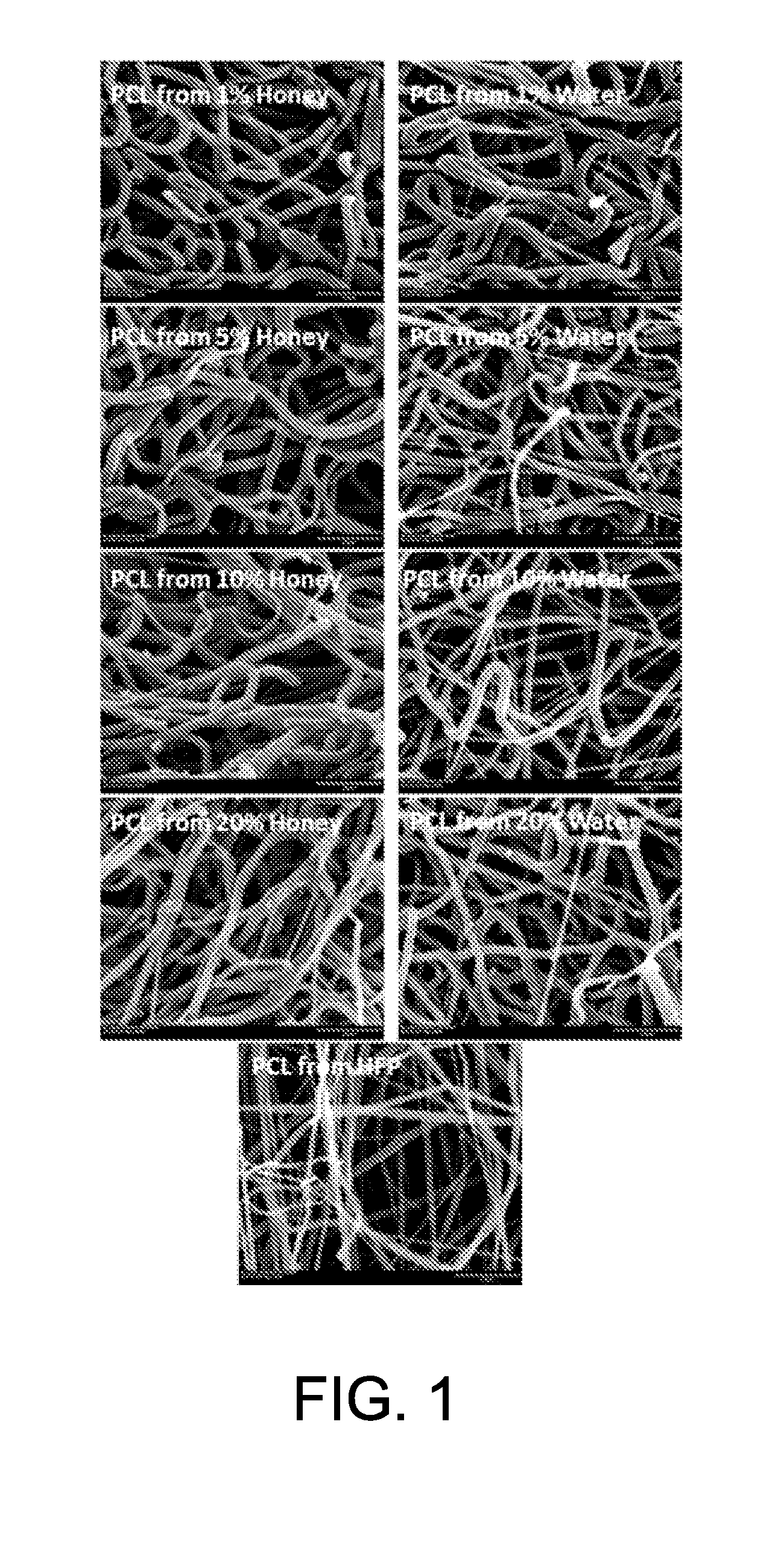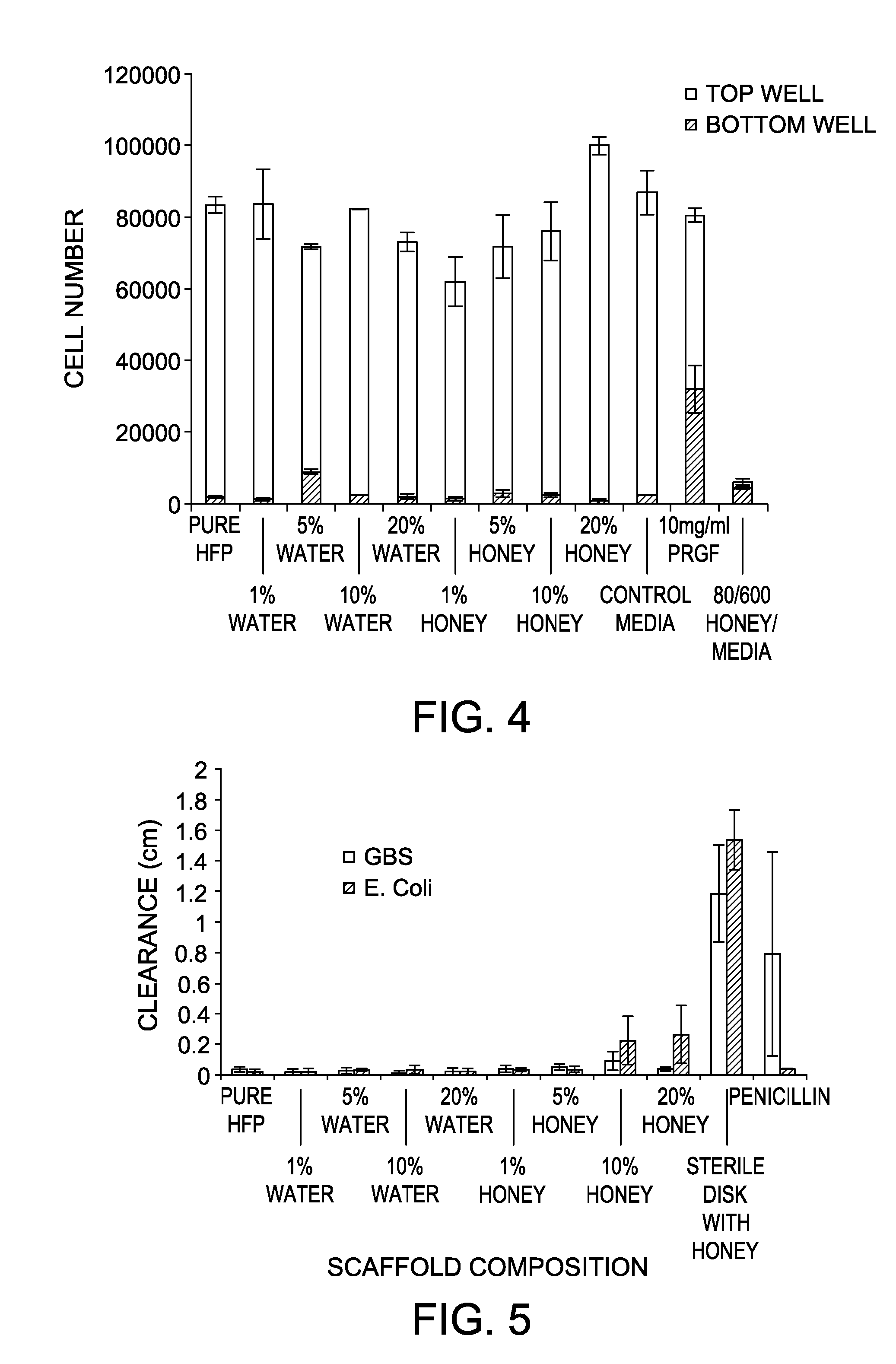Honey and growth factor eluting scaffold for wound healing and tissue engineering
a growth factor and eluting technology, applied in the field of tissue engineering structures, can solve the problems of difficult structure processing, penicillin significantly reducing the use of honey in medicinal applications, etc., and achieve the effect of sustained biomolecule release and enhanced bioactivity
- Summary
- Abstract
- Description
- Claims
- Application Information
AI Technical Summary
Benefits of technology
Problems solved by technology
Method used
Image
Examples
example 1
[0048]In this Example, tissue engineered scaffolds containing honey and platelet rich plasma / powdered preparation rich in growth factors (PRP / PRGF) were prepared.
[0049]PRP and PRGF were created from human blood. Briefly, fresh human whole blood from 3 donors was purchased (Biological Specialty Corp.), pooled, and used in a HARVEST® SMARTPREP® 2 (Harvest Technologies Corp., Plymouth, MA) centrifugation system to create PRP according to the manufacturer's protocol. PRP was then subjected to a freeze-thaw-freeze (FTF) cycle in a −70° C. freezer for cell lysis (centrifuge tubes containing PRP were placed in a −70° C. freezer for 24 hours followed by a 37° C. water bath for 1 hour, and then returned to the −70° C. freezer for 24 hours). Frozen PRP was then lyophilized for 24 hours to create a dry PRGF powder which was finely ground in a mortar and pestle prior to use.
[0050]Manuka honey was mixed with 1,1,1,3,3,3 hexafluoroisopropanol (HFP) in increasing ratios (1-30%). Since the honey wa...
example 2
[0052]In this Example, tissue engineering scaffolds were prepared using increasing concentrations of honey.
[0053]Specifically, Manuka honey was dispersed through sonication into hexafluoroisopropanol (HFP) in increasing concentrations (1-20% v / v), into which 150 mg / ml polycaprolactone (PCL) was dissolved. These solutions were then electrospun onto a rotating stainless steel mandrel to form a scaffold. Controls used increasing concentrations of water, sonicated and dispersed in HFP (1-20% v / v) with 150 mg / ml PCL dissolved, or 150 mg / ml PCL dissolved in pure HFP. Scaffolds were then imaged with scanning electron microscopy (SEM, FIG. 1, 1500× magnification, 20 micron scale bar). From these SEM images, fiber diameter and porosity of these scaffolds were measured using ImageJ image analysis program (FIG. 2).
[0054]Manuka honey was successfully dispersed in the HFP solution using sonication, where previous attempts (dissolving liquid honey, dissolving lyophilized honey, high speed vortexi...
example 3
[0055]In this Example, tissue engineered scaffolds were evaluated for mechanical testing and degradation.
[0056]Specifically, samples for mechanical testing and degradation evaluation were punched from electrospun scaffolds and placed in sterile phosphate buffered saline (PBS) under standard cell culture conditions. Samples were removed at specified intervals (day 0, 1, 4, 7, 14, 21, and 28) and uniaxially tested to failure on a Mechanical Testing Systems Criterion 42 testing system at an extension rate of 10 mm / min.
[0057]It was demonstrated that mechanical strength of the electrospun scaffolds decreased with increasing amounts of either water or honey. Surprisingly, it was demonstrated that the presence of the Manuka honey within the scaffolds did not significantly impact the rate of scaffold degradation over the 28 days of incubation (FIG. 3). PCL, while traditionally a slowly degrading polymer, breaks down through hydrolytic interactions which can be exacerbated through local decr...
PUM
| Property | Measurement | Unit |
|---|---|---|
| diameter | aaaaa | aaaaa |
| diameter | aaaaa | aaaaa |
| porosity | aaaaa | aaaaa |
Abstract
Description
Claims
Application Information
 Login to View More
Login to View More - R&D
- Intellectual Property
- Life Sciences
- Materials
- Tech Scout
- Unparalleled Data Quality
- Higher Quality Content
- 60% Fewer Hallucinations
Browse by: Latest US Patents, China's latest patents, Technical Efficacy Thesaurus, Application Domain, Technology Topic, Popular Technical Reports.
© 2025 PatSnap. All rights reserved.Legal|Privacy policy|Modern Slavery Act Transparency Statement|Sitemap|About US| Contact US: help@patsnap.com



